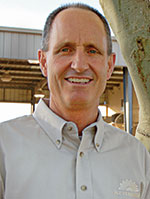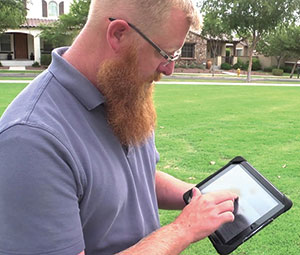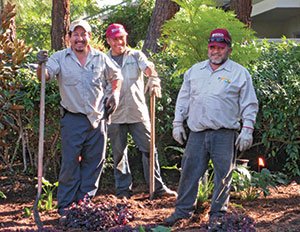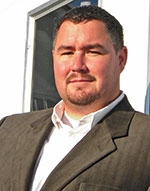The companies on the LM150 list are chock full of good ideas that firms of any size can learn from. We take a look at 13 programs, systems and philosophies that can help you boost business in 2013 and beyond.
1. Un-subcontracting
Company: American Landscape Systems
Location: Lewisville, Texas
LM150 rank: 111
Hiring subcontractors can be expensive, and after a decline in profits in 2011 the folks at American Landscape Systems were on a quest to save money.

So in 2012, the company decided to bring in-house all the landscape services it had been shipping out to subcontractors, including chemical applications, hydromulch services, mowing and tree services.
The move paid off. Why? Because in 2012 American Landscape Systems was able to recapture 100 percent of the profits it previously had lost to subcontracting.
“At the end of 2011 we looked at how much we spent on subcontractors. It was almost $1 million,” says American Landscape Systems Vice President Joseph Angelone. “Our goal at the beginning of 2012 was to capture more of the profit of the annual revenue we were performing.”
In looking at its numbers from 2011, American Landscape Systems had to reevaluate its practices. Bringing services in-house enabled the company to establish a stronger presence in the competitive Dallas market.
“Costs are consistently rising, but our prices are decreasing because of how competitive it is,” Angelone says. “We have to do everything we can now to keep as many of our services in-house as possible.”
In making the transition, the company made an initial investment of $200,000 in equipment and staff. It trained its workers, hired a licensed applicator and bought chemical application equipment, trucks, trailers and hydromulch equipment.
“To spend $200,000 in light of the $1 million we were spending previously, it seemed like the right idea, and it turned out it was,” Angelone says. “And I’ll tell you what, we won’t go back. No more subcontractors on landscaping services. It’s such a bad marketing tactic to have another landscape company on one of your projects.”
It’s much better, he says, to have your own employees—and American has 110 of them year-round—getting face time and interacting with clients.
Today, the company pays for minor upkeep on the equipment as well as for the ongoing labor costs, which are only about 20 percent of what they were with subcontractors.
“Now we can capture $750,000 to $800,000 more of gross profit than we could before,” Angelone says.
Finding an experienced licensed chemical applicator wasn’t easy, Angelone adds, so the company hired a new person with no experience, sent him through training and built the department around him. “It took four to six months for us to get him ready, but he matched our company style,” Angelone says.
The insourcing delivered, and not only on profits.
“There was better and more consistent communication overall, and we have more knowledge of what’s happening on our properties,” Angelone asserts. “We’ve long been a full-service company. Now we’re a full-service company that’s doing it all on our own.” —Beth Geraci
2. Moving to a four-day workweek
Company: Clean Scapes
Location: Austin, Texas
LM150 rank: 53
Never underestimate the power of a good motivational seminar.

After attending a GIE+Expo presentation extolling the virtues of the four-day workweek, Ivan Giraldo decided to implement the idea at his company.
“We started pushing it very hard and implementing it in 2008,” says Giraldo, who is president of Austin, Texas-based Clean Scapes.
Five years later, Giraldo is pleased with the results.
Shifting the company’s property-maintenance crews to four-day workweeks has reduced overtime and helped manage steadily creeping fuel prices, Giraldo says.
The shorter workweek has led to a 10 percent reduction in overall labor costs for the company’s property-maintenance division, which employs 130 or so people during the busy season, he says.
Giraldo also has seen a reduction in vehicle wear and tear.
“The less time they’re out on the road, the better,” he says.
Less time on the road also equals less fuel consumption. While Giraldo notes that rising fuel prices have erased any potential savings from the shorter workweek, the company has been able to keep its fuel costs flat—a nice achievement in today’s environment.
There have been a few speed bumps. Hourly crew workers worried that their paychecks would take a big hit from the shorter workweek.

“We had a little bit of pushback from the crew members,” Giraldo says.
They bought in, though, when they saw they still could log 40 hours of work—plus a few hours of overtime—in a four-day span, with the added bonus of an extra day off.
Another concern was getting five days’ worth of work done in four days. However, Giraldo notes that property-maintenance crews have adapted beautifully.
“When you’re doing the work in four days, you need to plan it better,” he says. “The guys just work a little more efficiently, because they know that they have to finish the job in four days. Even if they would like to work more hours, night will come eventually, and they cannot work anymore.”
Around the same time Clean Scapes shifted to a four-day workweek, the company installed GPS tracking devices on all of its trucks. While Giraldo emphasizes that the company uses the devices to help with time tracking, route selection and job costing—and not as a punitive tool—he acknowledges the mere presence of the GPS devices encourages workers to use their time efficiently.
“Of course everybody knows it’s there, so everybody becomes a little more conscious of how they spend their time,” he says. “If I used to spend an extra 15 or 20 minutes at the 7-Eleven, now I know that I shouldn’t and I can’t because that’s going to be registered on my GPS.” —Josh Cable
3. Using mobile technology
Company: DLC Resources
Location: Phoenix, Ariz.
LM150 rank: 72
Landscape companies provide the most value when their crews are out in the field—not in the office filing paperwork.

That’s why Phoenix-based DLC Resources equips its managers, foremen and other field personnel with iPhones and iPads, CEO Jeff Penney explains.
“This is about harnessing technology to drive value,” Penney says. “Value to us is: 1). keeping our field managers out of the office and in the field with our clients, and 2). being more in tune with our customers’ needs.”
Since the initial rollout in spring 2012, Penney estimates that 130 field personnel—including foremen, mechanics and irrigators—now have iPhones, while some 30 department and field managers have iPads.
Penney points to several examples of how the mobile devices have boosted communication, improved document management and made processes more efficient.
Armed with iPhones, foremen now electronically file their timecards on Friday afternoons, versus the old method of bringing their paper timecards to the office on Monday mornings.
“So now on Monday mornings, we’re talking about the future with our people,” Penney says. “We’re not talking about the past—that’s already been wrapped up.”
The devices also have changed the dynamic between field personnel and customers.

Each planned community serviced by DLC Resources has access to a customized Web portal, which includes work orders, proposals, weekly schedules, maps and other pertinent information for the landscaper and the client.
Field managers now can connect to the Web portals via an icon on their iPads, giving them access to key project documents that previously might have been available only in paper form.
“Essentially, everybody is updated on an hourly basis, so [customers’] need for sit-down time with us is less, because we’re not talking about the past, if you will,” Penney says. “And when we do sit down with them, we’re talking about the future— not ‘Here’s what we did.’ That’s already been communicated.”
Among other key benefits, the mobile devices have made it easier to locate underground utilities. Using Google Maps and an iPad app called GIS Pro that harnesses geographic information system technology, field personnel can geolocate underground utilities—or “blue stakes,” as they’re called in some parts of the country—more precisely before excavating.
“It removes the guesswork from the process,” Penney says.
While DLC Resources is reaping the benefits of equipping its field personnel with electronic devices, this is not the company’s first foray into mobile technology. Prior to spring 2012, field managers carried BlackBerrys.
However, the company has found that the Apple devices “are a lot more capable and user-friendly,” Penney says.
“Some of our power users who had iPhones for personal use had to educate us,” Penney says. “They said, ‘Hey, these things are a lot better, and they’ll be better for work.’” —Josh Cable
4. Hosting client education sessions
Company: Earthworks
Location: Lillian, Texas
LM150 rank: 95
You don’t have to be a schoolteacher to be rewarded for educating others. Just ask the staff at Earthworks. In 2009, Earthworks began educating its commercial clients on drought management and water conservation methods. It found that teaching can be quite profitable.

“When the economy started to tank, our clients wanted to save money, and we saw a move from them to start to do irrigation repairs themselves,” says Earthworks President Chris Lee. “We thought, ‘This could either be a terrible thing or it could be an opportunity for us.’”
To create goodwill, Earthworks decided to talk to its clients and explain to them the right way to make those repairs—not for a fee, just as a courtesy. The result surprised Lee.
“Inadvertently, it started to drive new business our way,” Lee says. “It convinced people that they didn’t have the resources to do these repairs and would have to come up with the money. They didn’t understand that there are miles of pipe and water pressure and electricity. They realized, ‘Wow, there’s a reason people get licensed to do this.’”
Earthworks’ initiative to educate clients on responsible water use took another lucrative turn in 2012, when conversations about water shortages, restrictions and drought became more frequent in Texas, faced as it was with one of the fastest-growing populations in the country.
Earthworks began hosting free monthly classes for clients, classes that covered the efficiency of ET-based controllers, drip irrigation and other water-related tools and methods.
The classes inform clients not only about water issues, but also about the impact of shade on plants, tree trimming’s importance and how to budget for projects in the long term.
“We don’t ever try to sell them anything,” Lee says. “We don’t want people to get the impression that that’s the point of the class and then miss the intent of the program—which is just to educate them.”
Despite its good intentions, the program is translating into a profiable endeavor. For one, it costs Earthworks very little to implement, other than the time it takes to strategize the classes and the cost of the breakfast or lunch the company serves during the sessions. The company hasn’t had to make any new hires for the initiative, either.
Lee says the free classes, along with customer referrals garnered from it, generated about $400,000 in new maintenance accounts for Earthworks in 2012, accounting for just more than 3 percent of its $13.1 million revenue.
“It’s actually turned out better than expected, because it’s brought us additional revenue,” Lee says. “We’ll give these classes to 10 of our properties and then one of the higher ups says, ‘Wait, will you do it for all 30 of my properties?’
“They see we’re investing in them,” Lee says, “so it works out that we pick up new business and we have better goodwill in the market.”
For other companies looking to capitalize on client education, Lee has one recommendation: “Look at the biggest education shortfalls in your area. Ask yourself, ‘Where is the biggest opportunity to make a difference?’ Then go there.” —Beth Geraci
5. Refocusing on client relationships
Company: Integrated Landscape Management
Location: Tempe, Ariz.
LM150 rank: 86
Integrated Landscape Management’s customer-retention rate has consistently registered in the 90 percent range, says Robert Clinkenbeard, founder and co-owner. The company’s focus on customer satisfaction is a major reason ILM has grown from a small start-up out of a garage to a $15 million operation with 270 full-time employees.

Clinkenbeard and John Garigen founded the company in 2001 and have focused on steadily growing the business by building client relationships. As the company has expanded, Clinkenbeard has further emphasized client retention and employee professionalism.
Last year the company invested in additional client relationship training. One training exercise involves weekly role playing on potential customer concerns. ILM account managers involved in the role-playing exercise then will review processes and procedures to handle client complaints.
In addition, Clinkenbeard has redefined account managers’ responsibilities so they’re more focused on serving clients. They’re not expected to handle as many operational issues as they had in the past, such as staffing issues, Clinkenbeard says.
ILM also conducts quarterly meetings with select customers to find out how the company can improve its service, Clinkenbeard says. “We recognize our clients are busy, so we try to identify ways to make their jobs easier, maybe by less paperwork and making the process simpler so they don’t have to worry about their landscaping,” Clinkenbeard says.
For instance, ILM plans to release an app in June that that will allow clients to view their property’s quality scores or request work on the property. ILM primarily serves commercial clients, so the app is designed to help these customers save time and focus on their core responsibilities.
The company is also hiring account managers who are more professional and “polished,” Clinkenbeard says. “I think all those things are contributing to higher retention rates and higher extra sales,” he says.

Customer-satisfaction surveys indicate the company’s efforts have paid off. Two years ago the company’s customer-satisfaction rate was about 75 percent and the most recent survey score was about 90 percent, Clinkenbeard says.
As Clinkenbeard implemented these client-centric processes, he realized the importance of leveraging employees’ core strengths. “The biggest lesson is trying to find where people’s core strengths are, so if somebody’s strength is being in the field or operations, that’s where they should be,” Clinkenbeard says.—Jonathan Katz
6. Nurturing client relationships
Company: Mission Landscape Companies
Location: Irvine, Calif.
LM150 rank: 39
You don’t build relationships sitting behind a desk, says David DuBois, president and CEO of Mission Landscape Cos. in Irvine, Calif. Sluggish growth following the global recession forced DuBois to rethink his company’s approach to developing clients.

“We pulled back and said, ‘Let’s go back to our roots and build on relationships,’” DuBois says. “I feel this industry is more relationship driven. We made some adjustments on staffing and converted our efforts to what can we do to nurture the relationships and build them out further.”
In 2012, DuBois eliminated three traditional sales positions, added an event marketing person and asked his vice presidents and regional managers to focus on the company’s existing client base. The initiative required top-level managers to address client needs with in-person visits vs. phone calls and emails.
So far, the strategy has paid off. In 2012 the company experienced 13.5 percent growth compared with 11 percent growth in 2011, DuBois says.
Face-to-face communication gives Mission Landscape managers an opportunity to educate customers on seasonal needs, such as overseeding in the late summer, and other services that are available, DuBois says. For example, the company recycles tree trimmings into mulch. Mission Landscape then offers mulching at a discount to customers receiving the trimming service since the company doesn’t have to transport the material.
The approach is particularly useful with the commercial clients that Mission Landscape serves. That’s because commercial customers are typically working within a budget. “You have to be ahead of them; you have to let them know what’s coming next,” DuBois explains. “In the commercial market they’re always forecasting. Looking ahead on the quarters makes a big difference rather than being reactive on a month-to-month basis.

Company managers also drop in to tell clients when Mission Landscape employees will be working on their property. “Some of the best people on our team have stopped by on the simplest things, such as letting them know we’re doing tree work on a Saturday,” DuBois says. “Today emails get buried. That little touch is pretty basic but effective.” —Jonathan Katz
7. Mandating continuing education
Company: The Pattie Group
Location: Novelty, Ohio
LM150 rank: 136
Employee education has long been a priority at The Pattie Group, says Jonas Pattie, LIC, executive vice president, and from the moment they’re hired, all employees are given a career path and a job “buddy.” And training isn’t just provided, it’s required. Everyone in the company must take 45 hours of continuing education each year and is given a minimum annual budget of $300 to that end.
Growth depends on excellent employees, says Pattie, and excellence comes from giving employees the tools to develop and learn. “When you’re lucky enough to find people in this industry, you want to keep them and you want them to grow and get better, and you want them to see a career path in this industry, not just a job.”
Out of the 45 required education hours, some training is done in-house by The Pattie Group experts. For example, the company may organize a training seminar by their head arborist to talk about tree disease. In other cases, particularly for sales, employees will take courses externally.

The company started its education program 15 years ago and has refined it in the last five years to provide clarity and more tools so everyone is aware of the expectation. One example: The group recently reworked its evaluations to make them more specific, detailed, actionable and measurable.
“From the moment an employee walks in the door, we want them to know what their goals are, what’s expected [of them], what they’re measured on, and really what it takes to be considered an excellent employee,” says Pattie.
Education doesn’t come cheap, however: Pattie estimates the annual cost of classes and paying speakers to come in easily runs $25,000, and that doesn’t include downtime when employees are in class.
For others who may want run an employee education program, Pattie says organization and planning are key. He recommends getting advice from local business organizations or using consultants. You’ll need schedules, syllabi and systems—and don’t forget testing to make sure the training is hitting home. (The Pattie Group used J.P. Horizons to help set up its program.)
Flexibility is another vital component of a good training program. Is it tree planting season and staff members are making mistakes? Don’t get upset, says Pattie. Train. “We’ll say, ‘Hey, we’ve seen X, Y and Z on a couple of jobs. We think we need to review this,’ and then we’ll do a hands-on training session.”
The Pattie Group knows that happy employees make happy customers, and its training program leads to that end. “We’ve had people ask, ‘How can you afford to do this?’” he says. “The question is, how can you afford not to?” —Danielle Beurteaux
8. Refining crew hour management
Company: Southern Botanical
Location: Dallas, Texas
LM150 rank: 76
Dale Selby is excited, because in 2012 Southern Botanical strove to better manage its crew hours, and the company succeeded.

Southern Botanical turned away from Excel to a cloud-based program called Method Integration to track its crews’ hours and overtime.
“We said, ‘Let’s automate this and see some results from it,” says Selby, Southern Botanical’s director of corporate finance.
Now, with just a few clicks of the mouse, Southern Botanical can judge when a crew is bordering on overtime and sub in another crew to cover for it. Method Integration also enables Southern Botanical to track vehicles. “It shows where efficiencies lie or where they don’t lie,” Selby says. “Are we routing correctly? How efficient is our team?”
For a company that has 150 crew workers and foremen in the field, those are important questions to answer.
Selby didn’t divulge the cost of the program, acknowledging simply, “It’s not cheap.” Nonetheless, he says Southern Botanical leaders “feel like we’re making a great investment in the company. We plan on growing a lot from it.”
Selby says the program makes life easier for employees. Company leaders want to see that continue, because if their crews’ jobs are easier, workers can focus on their more important duties—like making clients happy. “I think our teams are stronger because of (Method),” Selby says. “It serves as motivation for them because they see we’re making an investment in them.”
Southern Botanical has taken other steps to grow in the last year, among them: bringing its tree care and pool work in-house and encouraging staff to pursue professional certifications and participate in industry associations.
Because of all those initiatives, Southern Botanical is poised for nearly 20 percent growth from 2012 to 2013, Selby says. In fact, he adds, the company had its best month ever this March, when it saw $2.56 million in top-line revenue.
As for implementing Method itself, Selby says it’s been a little bit of a slow process, but the company is now seeing good returns from it. “We were just looking for a more robust system,” he says. “We initially just used it to route our crews, and it’s been sort of a growing process between Method and ourselves, uncovering all the different things we can do.” —Beth Geraci
9. Rebranding
Company: The Stockner Group
Location: Rockville, Va.
LM150 rank: 114
What do you do when your family company has outgrown its roots? Rebrand. That’s what The Stockner Group did when its leaders realized they needed to educate clients about the many facets of their business. Started by the current owners’ grandfather in 1981 as a nursery, the company’s expertise now encompasses everything from hardscaping to snow removal—but its reputation hadn’t kept pace with the growth.

“We needed people to know The Stockner Group means a lot of different things, that this division specializes in irrigation, this division specializes in grounds management, this division in landscape,” says President Gary Stockner.
The rebranding initiative was the idea of newly hired COO Steven Cohen, who was brought in to help direct the company’s growth. By bringing clarity to the brand, says Stockner, current and potential clients now know that Stockner’s is a one-stop shop for grounds care, and each division is run by experts with many years of experience.
The rebranding took about $50,000 of the company’s $100,000 annual marketing budget, for things like resigning the trucks and advertising. Stockner’s main concern was people would think the firm was rebranding for the wrong reasons—like financial difficulties—and he wanted people to know that Stockner’s is still a family company with the same culture. But he’s very pleased with the overall results. “Now we’re really educating our market on what we are and who we are,” he says. “It’s easier to tell our story now.”
As the rebranding was under way, The Stockner Group launched its green initiative in spring 2012, knowing environmental sustainability is the future of landscaping. And it intends to walk the talk. “So many of our competitors talk about green initiatives, but are they using propane, are they using electric-powered blowers like we are?” Stockner asks. “We educate the clients about why we’re doing it and how it can add value to what they’re receiving.”
The company began with a gradual integration of equipment, starting with propane-powered mowers, a compost pile, electric-powered trimmers and blowers and organic lawn treatments. It replaced and upgraded equipment as needed in phases. The company also has introduced green guarantees in some multi-year contracts, pledging an annual increase of environmentally sound practices over the life of the agreement. Clients see The Stockner Group is taking environmental sustainability seriously, Stockner says, and can hold them accountable.
Companies thinking of a rebranding initiative must educate clients on how the results will benefit them. Says Stockner: “A rebrand is not about you, it’s about servicing your clients better.”
And green initiatives are great, he adds, but you have to really believe and do them—they’re a long-term, evolving commitment. Clients are smart; they know when you’re not really committed. “Everyone’s got to buy in and take it seriously.” —Danielle Beurteaux
10. Hiring a full-time recruiter
Company: Swingle Lawn, Tree & Landscape Care
Location: Denver, Colo.
LM150 rank: 66
The idea to hire a full-time recruiter had been bouncing around Swingle Lawn, Tree & Landscape Care for a couple of years, and while the company knew having a hiring expert on board would alleviate some of the existing staff’s workload and give the company a competitive edge, it held off because of the recession. As the economy began to improve over the last few years, Swingle was already having difficulties finding qualified personnel. So many people had left the landscape industry during the recession that Swingle found itself in a bit of a hiring bind trying to get experienced employees to return and make potential employees aware of the career opportunities in the business. Company leaders made the move and hired a full-time recruiter last spring.

The results, says CEO and owner Tom Tolkacz, will be gradual and long term.The goals are employee recruiting, retention and development and moving to a proactive instead of reactive approach to hiring—always having a pipeline of quality candidates available, something he sees as a necessity for business growth.
He says landscape industry experience is not the most important qualification in a recruiter. He looked for someone who was passionate about searching out the best candidates, understood the company’s core mission and values and could effectively sell Swingle as an employer and sell the Green Industry as a career path.
Tolkacz’s advice for other landscape companies thinking of doing the same: Recognize your company’s tipping point when it comes to staffing. “When landscape companies grow into the region of 100 or so employees, then recruiting starts to be a full-time situation,” he says, and that work will become a burden to existing staff. “That’s the point in time that a company of that size should consider hiring a recruiter.”
The spring has been tough for Colorado landscapers, as winter’s cold and snow persisted, and demand for Swingle’s services has been lower than usual, which has led to overstaffing. “This time last year, we were probably 15 percent understaffed and this year we’re about 15 percent overstaffed,” says Tolkacz. Colorado also is in a drought and under water restrictions, so Swingle has been using various forms of outreach, including social media, to educate residents about water use and how the drought will affect their landscaping.
But even though it’s been a tough first quarter, Swingle is committed to its improved recruitment process. “It would be very easy for us right now to say let’s not undertake that cost,” says Tolkacz. “But I truly believe for our vision and where we’re headed, it’s something we need to do.”
How did Swingle find its recruiter? A recruiter, of course. Tolkacz’s only regret is he didn’t hire one sooner. —Danielle Beurteaux
11. Going paperless
Company: TBG Landscape
Location: Brooklin, Ontario
LM150 rank: 84
Mark Bradley isn’t a big fan of paperwork—in particular, the kind that involves actual paper.

“Paperwork is so unsystemized, so free,” says Bradley, president of Brooklin, Ontario-based TBG Landscape. “People can write whatever they want on a sheet of paper. That leads to a lot of questions, and when there are questions, that means there’s a lot of back and forth [between the company and the client], and a lot of guessing.”
Through the use of mobile devices and cloud-based information sharing, paperwork is becoming a thing of the past at TBG Landscape—and the company’s bottom line is reaping the benefits.
The paperless “evolution” began about five years ago, Bradley says, when the company started using budgeting and estimating software in the Landscape Management Network (LMN), an online suite of business tools for landscaping contractors. Bradley is co-founder of LMN.
“It’s cloud-based, and it allows us to share estimate information, in real time, between our salespeople and customers, and ultimately to break the information down to the crews,” Bradley explains. “From an estimating and sales perspective, [field personnel] don’t have to rely on looking at an estimate spreadsheet and wondering if this is the latest version, or if they’re reviewing something that isn’t right and approving something that isn’t what the salesperson is currently presenting,” Bradley says.
The company saw enough value in the cloud-based approach that it decided to apply it to other functions.
TBG developed an in-house Web portal—“The Hub”—to enable field personnel to access project information, time sheets, HR forms, equipment-repair requests and other previously paper-based documentation, all on their mobile devices.
Coinciding with the shift to cloud-based data sharing, the company has invested in tablet PCs for its supervisors and independent workers and put mobile devices in the hands of more of its field personnel.
Overall, the results of the paperless initiative have been nothing short of “fantastic,” Bradley says. Given TBG’s rapid growth, the company likely would’ve needed two full-time administrative employees to process and compile the paperwork associated with timekeeping forms, equipment-repair requests, refueling orders, vendor transactions and other functions. With all of those tasks now conducted electronically, TBG has been able to redeploy one administrative employee and avoid hiring a second one, Bradley says.
“The operational savings that I get in a week probably would pay for what we’ve invested in the tablets,” Bradley says.
Likewise, the budgeting and estimating software “paid for itself in the first month, in terms of better pricing and overhead recovery.”
“I could never have had the number of estimators that we have and have that much confidence in pricing,” Bradley says. “It saves me hours of reviewing estimates.” —Josh Cable
12. Increasing in-person client communication
Company: Terracare Associates
Location: Littleton, Colo.
LM150 rank: 42
There’s something about face-to-face communication that makes for a tighter bond between a company and its clients. And in 2012, the staff at Terracare Associates got a valuable lesson in that, monetarily and otherwise.

In late 2011, Terracare devised a plan to strengthen client relationships, ramping up its efforts to communicate with every client in person and tracking staff’s communications with each. The initiative, says President Dean Murphy, applies to everyone from managers down to field superintendents.
“We established a requirement to meet with our clients from twice a year to once a month, depending on the position,” Murphy says. “We’re trying to listen and ask questions instead of assuming.”
Terracare tracks its client touches with spreadsheets. Murphy says the company shows its appreciation for clients based on customers’ interests. One Terracare salesperson, for instance, is an ex-professional golfer who gives clients free lessons, then takes them out for a round of golf. “Clients think that’s really cool,” Murphy says.
Although it’s still too early to see major returns on its customer touches, Terracare’s customer retention numbers are up by about 4 percent from 2012 to 2013, Murphy estimates. And although the company’s spent slightly more on marketing in the last year, the overall cost of implementing the changes has been minimal, Murphy says.
“It’ll be money well spent, absolutely,” he adds. “We wouldn’t spend this much time on it if we didn’t think it would work out. Think about it, at the end of the day who do you want to do with business with?”
But relationship building is not without challenges, especially for a staff that long has been focused on operations. “We need the softer skills now,” Murphy says. “Relationship building takes work. It takes patience.”
Having a successful business depends on many things, Murphy says, but nothing is more important than customer service. “Production is great, safety is paramount, operations is critical,” he says. “But if you don’t have clients, you don’t have a reason to do anything else.” —Beth Geraci
13. Training through growth
Company: Yard-Nique
Location: Morrisville, N.C.
LM150 rank: 87
Brian DuMont started Yard-Nique as a two-man operation shortly before graduating with a horticulture degree from North Carolina State University in 1997. Since then, the company has averaged 20 to 30 percent growth annually, except for the Great Recession year of 2008, and expanded its workforce to 260 employees.

DuMont attributes much of Yard-Nique’s success to a focus on “controlled growth.” That means occasionally turning down work to stay focused on core business practices, such as budgeting and ongoing training, DuMont says. It also means adapting to change. In recent years, DuMont noticed some of his longer-term employees struggling to accept the changes necessary for growth.
“One of the challenges was me having a vision and realizing some of the other folks aren’t aware of the vision,” DuMont says. “Some folks that had been with us eight, 10, 12 years have grown tremendously with the company, and everybody needs to continue to adapt and change or we will not be able to continue to grow as a company.”
DuMont addressed this communication challenge with enhanced training, evaluations and goal setting. Yard-Nique’s different divisions, installation and maintenance, each receive various training sessions at least once per month. The departments receive training on company standards to ensure everyone is on the same page, DuMont says.
A representative from each department leads 15-minute to 30-minute sessions on various topics, including safe mower operation, proper planting techniques and calibration of fertilizer spreaders. The training process also includes “ride-alongs,” when managers accompany crews to ensure everyone is following company expectations, DuMont says. Yard-Nique also invites vendors to provide training sessions.
In 2012, the company built an addition to its main office that includes a dedicated training and conference center. “We started adapting all of this over the last couple of years as we started to grow,” DuMont explains. “This past season we had close to 260 employees, so as you’re getting all of these employees on board, you have to think, “How do you make sure everything gets translated? I think communication and training is a big key to that.” —Jonathan Katz

